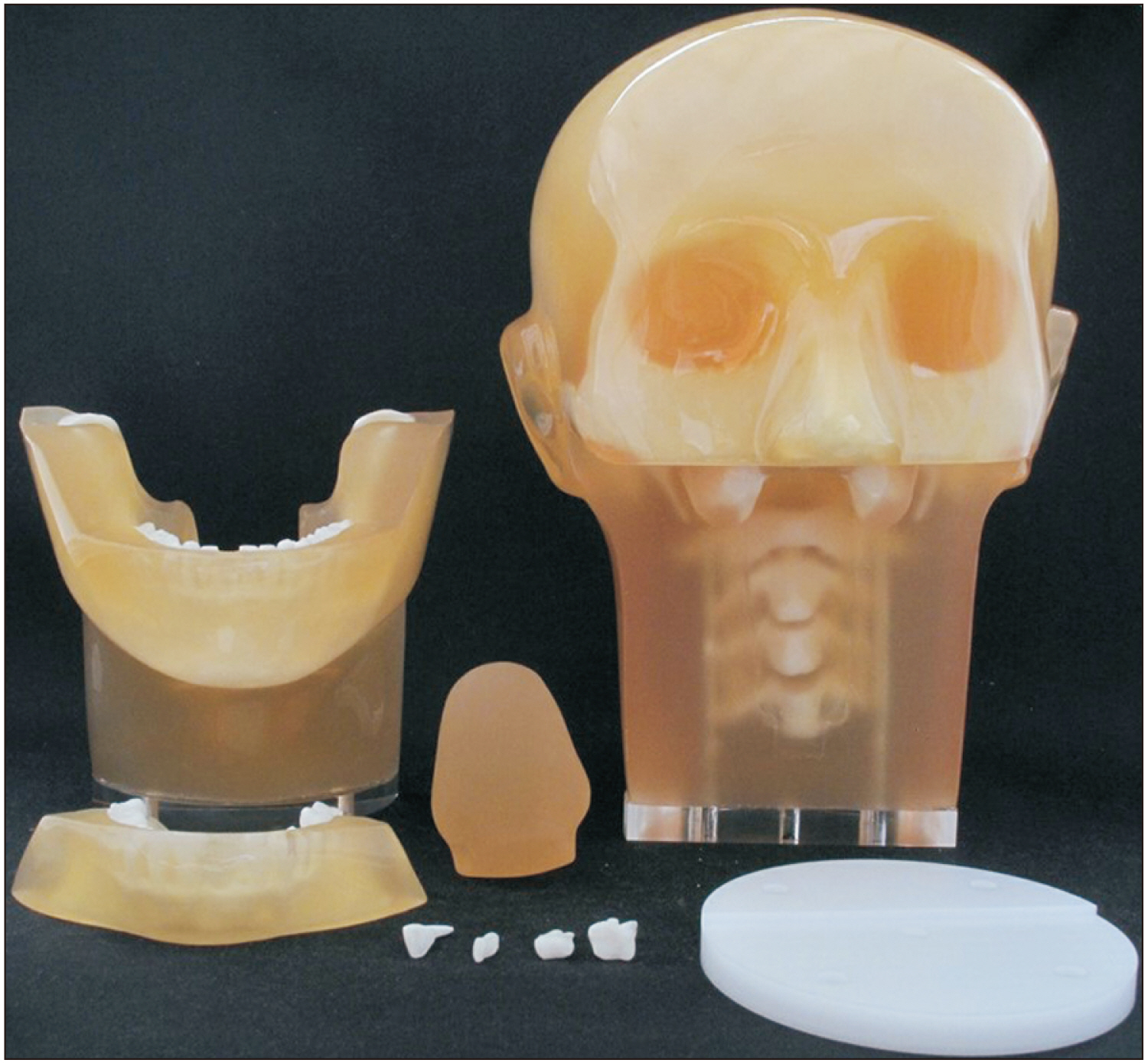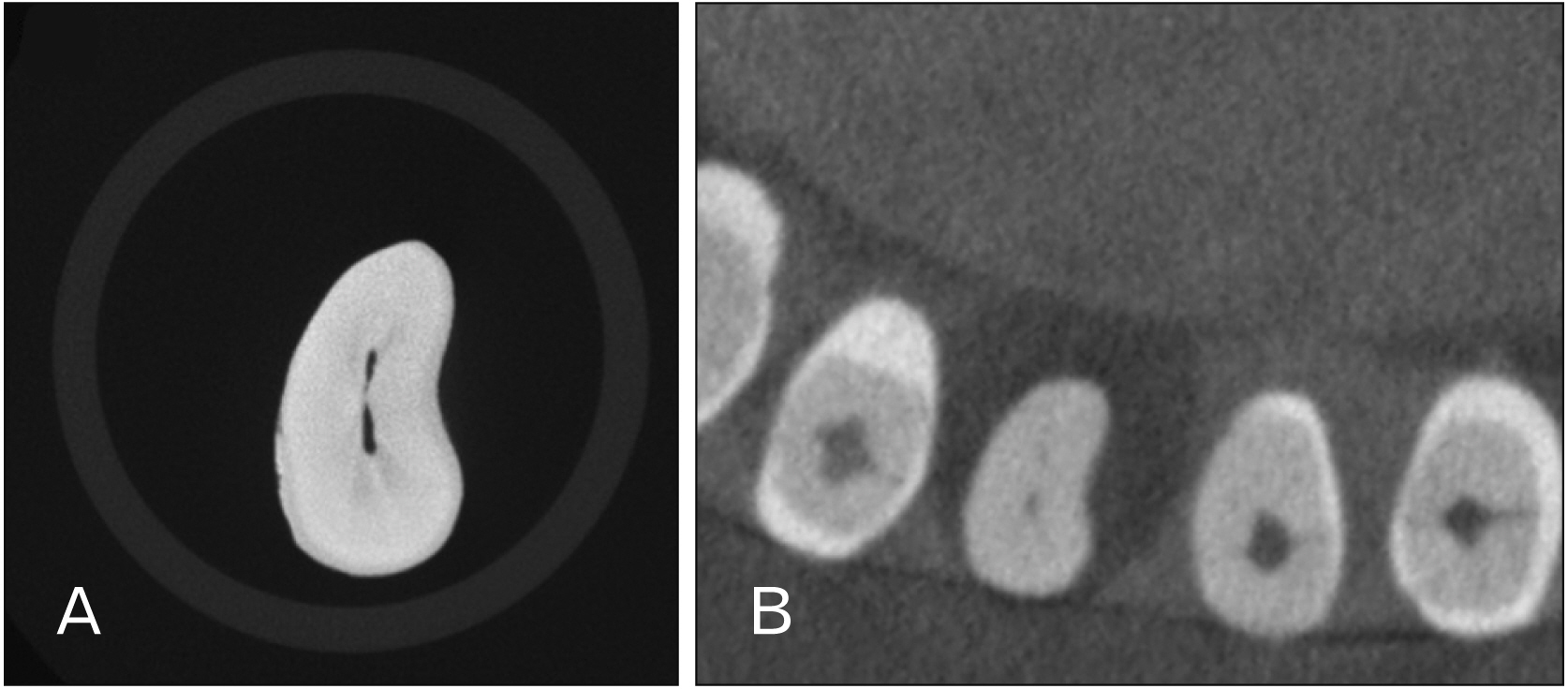Anat Cell Biol.
2023 Jun;56(2):185-190. 10.5115/acb.22.247.
Accuracy verification of dental cone-beam computed tomography of mandibular incisor root canals and assessment of its morphology and aging-related changes
- Affiliations
-
- 1Department of Morphological Biology, Ohu University School of Dentistry, Fukushima, Japan
- 2Department of Oral Radiology and Diagnosis, Ohu University School of Dentistry, Fukushima, Japan
- KMID: 2544079
- DOI: http://doi.org/10.5115/acb.22.247
Abstract
- The root canal morphology undergoes aging-related changes, and relevant quantitative analyses have not yet been reported. We compared the cone beam computed tomography (CBCT) and micro-computed tomography (microCT) scans of extracted mandibular incisors to check the accuracy of morphological measurements. Thereafter, the root canal morphology and aging-related changes in the mandibular incisors of Japanese individuals were assessed using CBCT. Six extracted teeth were fixed in a phantom head and imaged using CBCT and micro-CT. The correlation between the findings of the two imaging modalities was examined. Further, CBCT reconstructed images of the mandibular incisors of 81 individuals were observed. Age-related changes of the root canals were compared between participants aged <30 years and those aged ≥30 years. The CBCT and micro-CT findings regarding the root canals of the extracted teeth coincided in 94.4% of the cases. Mandibular incisors exhibiting two root canals in either cross-section accounted for 9.9% of central incisors and 12.4% of lateral incisors. Mandibular central incisors with two root canals were observed in two (6.3%) individuals aged <30 years and six (12.2%) aged ≥30 years. Mandibular lateral incisors with two root canals were observed in one (3.1%) individual aged <30 years and nine (18.4%) aged ≥30 years. CBCT allows accurate evaluation of complex root canal morphologies and is useful for endodontic preoperative assessment. Mandibular incisors have more frequent occurrence of two root canals with aging.
Keyword
Figure
Reference
-
References
1. Vertucci FJ. 1984; Root canal anatomy of the human permanent teeth. Oral Surg Oral Med Oral Pathol. 58:589–99. DOI: 10.1016/0030-4220(84)90085-9. PMID: 6595621.
Article2. Martins JNR, Gu Y, Marques D, Francisco H, Caramês J. 2018; Differences on the root and root canal morphologies between Asian and White Ethnic groups analyzed by cone-beam computed tomography. J Endod. 44:1096–104. DOI: 10.1016/j.joen.2018.04.001. PMID: 29861062.
Article3. Baxter S, Jablonski M, Hülsmann M. 2020; Cone-beam-computed-tomography of the symmetry of root canal anatomy in mandibular incisors. J Oral Sci. 62:180–3. DOI: 10.2334/josnusd.19-0113. PMID: 32224571.
Article4. Aung NM, Myint KK. 2020; Evidence of second canal between permanent mandibular central and lateral incisors in China; a systematic review on CBCT studies. Int J Dent. 2020:8849609. DOI: 10.1155/2020/8849609. PMID: 33343667. PMCID: PMC7728484. PMID: ddc8e9de561c4353801707952472d383.
Article5. Mahmood Talabani R. 2021; Assessment of root canal morphology of mandibular permanent anterior teeth in an Iraqi subpopulation by cone-beam computed tomography. J Dent Sci. 16:1182–90. DOI: 10.1016/j.jds.2021.02.010. PMID: 34484586. PMCID: PMC8403811.
Article6. Verma GR, Bhadage C, Bhoosreddy AR, Vedpathak PR, Mehrotra GP, Nerkar AC, Bhandari A, Chaubey S. 2017; Cone beam computed tomography study of root canal morphology of permanent mandibular incisors in Indian subpopulation. Pol J Radiol. 82:371–5. DOI: 10.12659/PJR.901840. PMID: 28794810. PMCID: PMC5513681.
Article7. Tolentino ES, Amoroso-Silva PA, Alcalde MP, Yamashita FC, Iwaki LCV, Rubira-Bullen IRF, Duarte MAH. 2021; Comparison of limited- and large-volume cone-beam computed tomography using a small voxel size for detecting isthmuses in mandibular molars. Imaging Sci Dent. 51:27–34. DOI: 10.5624/isd.20200144. PMID: 33828958. PMCID: PMC8007390.
Article8. Kim SY, Yang SE. 2012; Cone-beam computed tomography study of incidence of distolingual root and distance from distolingual canal to buccal cortical bone of mandibular first molars in a Korean population. J Endod. 38:301–4. DOI: 10.1016/j.joen.2011.10.023. PMID: 22341064.
Article9. Aytugar E, Özeren C, Lacin N, Veli I, Çene E. 2019; Cone-beam computed tomographic evaluation of accessory mental foramen in a Turkish population. Anat Sci Int. 94:257–65. DOI: 10.1007/s12565-019-00481-7. PMID: 30790181.
Article10. Vizzotto MB, Silveira PF, Arús NA, Montagner F, Gomes BP, da Silveira HE. 2013; CBCT for the assessment of second mesiobuccal (MB2) canals in maxillary molar teeth: effect of voxel size and presence of root filling. Int Endod J. 46:870–6. DOI: 10.1111/iej.12075. PMID: 23442087.
Article11. Blattner TC, George N, Lee CC, Kumar V, Yelton CD. 2010; Efficacy of cone-beam computed tomography as a modality to accurately identify the presence of second mesiobuccal canals in maxillary first and second molars: a pilot study. J Endod. 36:867–70. DOI: 10.1016/j.joen.2009.12.023. PMID: 20416435.
Article12. Morikage N, Hamada T, Usami A, Takada S. 2017; Topographical relationship between positions of lingual foramina and attachment of mylohyoid muscle in mental region. Surg Radiol Anat. 39:735–9. DOI: 10.1007/s00276-016-1804-9. PMID: 28078367.
Article13. Yoza T, Serikawa M, Sugita T, Harada T, Usami A. 2021; Cone-beam computed tomography observation of maxillary first premolar canal shapes. Anat Cell Biol. 54:424–30. DOI: 10.5115/acb.21.110. PMID: 34465669. PMCID: PMC8693140.
Article14. Shigefuji R, Serikawa M, Usami A. 2022; Observation of mandibular second molar roots and root canal morphology using dental cone-beam computed tomography. Anat Cell Biol. 55:155–60. DOI: 10.5115/acb.22.050. PMID: 35773218. PMCID: PMC9256481.
Article15. Suomalainen A, Pakbaznejad Esmaeili E, Robinson S. 2015; Dentomaxillofacial imaging with panoramic views and cone beam CT. Insights Imaging. 6:1–16. DOI: 10.1007/s13244-014-0379-4. PMID: 25575868. PMCID: PMC4330237.
Article16. Katsumata A, Hirukawa A, Okumura S, Naitoh M, Fujishita M, Ariji E, Langlais RP. 2007; Effects of image artifacts on gray-value density in limited-volume cone-beam computerized tomography. Oral Surg Oral Med Oral Pathol Oral Radiol Endod. 104:829–36. DOI: 10.1016/j.tripleo.2006.12.005. PMID: 17448704.
Article17. Bootsma GJ, Verhaegen F, Jaffray DA. 2011; The effects of compensator and imaging geometry on the distribution of x-ray scatter in CBCT. Med Phys. 38:897–914. DOI: 10.1118/1.3539575. PMID: 21452727.
Article18. Arai Y. 2021; Local cone beam CT: how did it all start? Dentomaxillofac Radiol. 50:20210276. DOI: 10.1259/dmfr.20210276. PMID: 34739304. PMCID: PMC8611279.
Article19. Scarfe WC, Farman AG. 2008; What is cone-beam CT and how does it work? Dent Clin North Am. 52:707–30. vDOI: 10.1016/j.cden.2008.05.005. PMID: 18805225.
Article20. Asami R, Aboshi H, Iwawaki A, Ohtaka Y, Odaka K, Abe S, Saka H. 2019; Age estimation based on the volume change in the maxillary premolar crown using micro CT. Leg Med (Tokyo). 37:18–24. DOI: 10.1016/j.legalmed.2018.12.001. PMID: 30597413.
Article21. Pineda F, Kuttler Y. 1972; Mesiodistal and buccolingual roentgenographic investigation of 7,275 root canals. Oral Surg Oral Med Oral Pathol. 33:101–10. DOI: 10.1016/0030-4220(72)90214-9. PMID: 4500261.
Article22. Nelson S. Nelson S, editor. 2015. Pulp chambers and canals. Wheeler's Dental Anatomy, Physiology, and Occlusion. 10th ed. Elsevier;p. 203–30.23. Berkovitz BKB. Standring S, editor. 2016. Oral cavity. Gray's Anatomy. 41st ed. Elsevier;p. 507–33. DOI: 10.37019/e-anatomy/826010.24. Special Committee to Revise the Joint AAE/AAOMR Position Statement on use of CBCT in Endodontics. 2015; AAE and AAOMR joint position statement: use of cone beam computed tomography in endodontics 2015 update. Oral Surg Oral Med Oral Pathol Oral Radiol. 120:508–12. DOI: 10.1016/j.oooo.2015.07.033. PMID: 26346911.25. Rabiee H, McDonald NJ, Jacobs R, Aminlari A, Inglehart MR. 2018; Endodontics program directors', residents', and endodontists' considerations about CBCT-related graduate education. J Dent Educ. 82:989–99. DOI: 10.21815/JDE.018.098. PMID: 30173196.
Article26. Miyashita M, Kasahara E, Yasuda E, Yamamoto A, Sekizawa T. 1997; Root canal system of the mandibular incisor. J Endod. 23:479–84. DOI: 10.1016/S0099-2399(97)80305-6. PMID: 9587315.
Article
- Full Text Links
- Actions
-
Cited
- CITED
-
- Close
- Share
- Similar articles
-
- Observation of mandibular second molar roots and root canal morphology using dental cone-beam computed tomography
- Nutrient canals on mandibular anterior region in cone beam computed tomography
- Endodontic treatment of maxillary lateral incisors with anatomical variations
- Endodontic management of a maxillary first molar with three roots and seven root canals with the aid of cone-beam computed tomography
- Asymmetry in mesial root number and morphology in mandibular second molars: a case report




